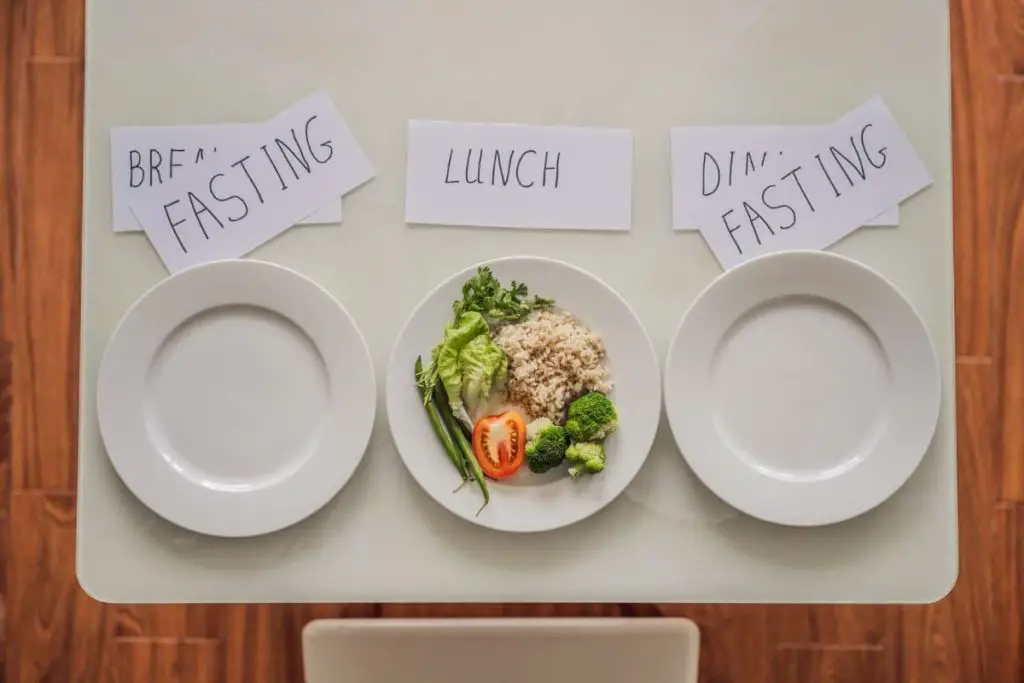Intermittent fasting is a great way to lose weight and adopt a healthier lifestyle. However, how do you stick to your intermittent fasting schedule and stay energetic while working a full-time job? Luckily, there are several ways to intermittent fast, so it’s easy to tailor a fasting window that fits around your working hours.
You can intermittent fast while working full time by following a fasting schedule that accommodates your work hours, such as eating from 8 a.m. till 4 p.m. and fasting thereafter. You can also consume beverages like tea and coffee while you work to curb hunger pangs or consume only one meal a day.
Intermittent fasting at work can initially seem challenging, as it’s harder to stay focused and energized, and you may be easily tempted to break your fast during work events. The rest of this article will detail how you can carry on intermittent fasting while working full-time.

1. Choose a Fasting Schedule That Works for You
Fortunately, there is no set intermittent fasting routine – you choose a schedule that works for your lifestyle. Let’s explore the best intermittent fasting schedules for full-time workers below:
The 16/8 Method
The 16/8 intermittent fasting method involves eating during an 8-hour window and fasting for 16 hours. It might sound extreme to fast for 16 hours; however, this is easily the most popular method as the majority of your fast can take place during sleeping hours.
You can also manipulate the time of this fast to have your eating window during work hours. For example, you can eat from 8 a.m. till 4 p.m. and fast for the remainder of the day. Or you can fast from noon till 8 p.m. if you’d prefer to eat dinner with your family. And if you’d rather eat at a later time of the day, then you can fast throughout your work day.
Furthermore, how you practice this method also depends on the type of work you do. For example, if you do physical labor or intense brain work like accounting, programming, etc., you’ll need food to concentrate and stay energetic throughout the day. In this case, you can eat breakfast and stop eating at 2 p.m.
There is no correct way to do the 16/8 method. You just need to choose a time that suits you best, as that’s the only way to remain consistent.
Consume Only One Meal a Day
According to WebMD, the One Meal a Day (OMAD) diet consists of not eating for 23 hours and consuming all your calories in a single meal. This diet is more on the extreme end of fasting. However, many have seen positive results not just in weight loss but in their overall health.
The OMAD fast is good for full-time workers as you can eat one big meal at noon. However, if your job is demanding and you find yourself constantly thinking about food, then following the 16/8 method might be a better option. It’s also good to consult with a doctor before attempting this fast.

The 5:2 Method
The 5:2 intermittent fasting method is also called The Fast Diet. It involves eating normally for five days and limiting your calorie intake to 500–600 per day for two days.
This schedule might work best for full-time workers as you can have your fasting days over the weekend and spend the rest of the week without the pressure of fasting.
However, the downside of this method is that you need to plan your calorie intake to be accurate. Several calorie-counting apps can help you do this, and you can get recipe recommendations too.
2. Consume Beverages During Work Hours
Consuming beverages like tea, coffee, and water during work hours will enhance your energy and focus and curb hunger pangs, as they make you feel full.
Many people mistakenly assume you must give up liquids during intermittent fasting. However, you don’t have to, provided you consume the right drinks. According to Healthline, having drinks with very low or zero calories during a fasting window will not compromise your fast in a significant way.
Therefore, you should have tea without sugar or milk and black coffee with no sugar, cream, milk, or any other additives. So, your Starbucks latte should be avoided.
Also, aim to drink plenty of water during your fast. Water will not only keep you hydrated but will improve your mood and focus and increase your metabolism.
3. Exercise Discipline To Abstain From Eating During Work Events
If you’ve chosen to have your fasting window during work, it might be challenging to stick with it when your team orders a nice lunch or if there’s a work event during the day. In such cases, you’ll need to maintain the discipline to stick to your fast.
However, you are only human, and breaking your fast on one day will not do any harm – just make sure that you try to stay consistent with your fast after that.
Additionally, it’s crucial to change your mindset about fasting. Instead of thinking it’s challenging to carry out, start seeing it as a good thing. Work actually keeps you busy, and it’s easier to stick to a fasting schedule than when you aren’t working and have the time to think about food constantly.
4. Plan and Prep Your Meals Ahead of Your Eating Window
Working full-time is exhausting – the last thing you need is to figure out what to cook when it’s time to break your fast. Therefore, you must plan your meals ahead of your eating window.
Here are a few advantages of meal prepping:
- It reduces your urge to binge eat and consume unhealthy snacks when you break your fast.
- It eliminates decision fatigue, as you don’t need to ponder what to eat.
- You can make healthier, balanced meals as you have time to prepare.
If you’re curious about using meal planning to make your life easier, watch this YouTube video by Lacey Baier:
5. Ease Yourself Into Intermittent Fasting
Intermittent fasting is a lifestyle change and can be stressful enough without the added pressure of balancing it with a full-time job. So, take your time and ease yourself into it. If you decide to be extreme and immediately go in with an OMAD fast, you might make yourself ill, and it’s likely that you’ll never want to intermittent fast again.
Try starting with the 12:12 fast and work your way up from there. This fast consists of an eating and fasting window of 12 hours each. It’s an easier fast as you can include your sleep hours in the fasting window.

Key Takeaways
Intermittent fasting while working full-time doesn’t need to be challenging. There are several ways to manipulate your fasting window to accommodate your working hours.
Here are a few reminders to make intermittent fasting easier and sustain energy and focus:
- Consume drinks like tea, coffee, and water to satisfy your hunger.
- Plan and prepare meals before your eating window.
- Experiment with different fasting schedules to see what works for you.
- Ease yourself into intermittent fasting to maintain consistency and motivation.

